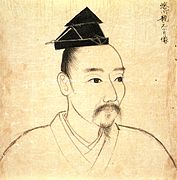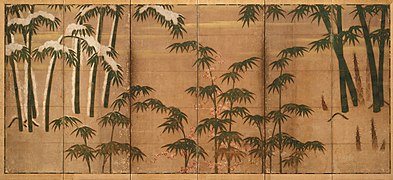Tosa Mitsunobu
Tosa Mitsunobu ( Japanese 土 佐 光 信 ; born 1434 ?, Died 1525 ?) Was a Japanese painter and founder of the Tosa School .
life and work
Tosa Mitsunobe was the most important artist at the imperial court from the end of the 15th century to the beginning of the 16th. He was appointed head of the Department of Painting (宮廷 繪 所 預, Kyūtei e-dokoro azukari) at the court in 1469 and worked until around 1525. During these fifty years at the court, he rose from “将 監” (Shōgen) “刑部 太 夫”(Gyōbu tayū) to“ 十四 位 下 ”(Jūyon'i ge). Mitsunobu not only worked for the court, but also for the shogunate, and he received considerable property. At first he had the family name Fujiwara, but from the Bummei era (1469–1487) he appears under the name Tosa Mitsunobu. At this time he received the property of a Hirochika / Hirokae, who already bore the name Tosa. It was the time when his relationship with the shogunate was also growing.
It is unanimously assumed that Mitsunobu was perhaps even the successor of Hirochika and so came to the name Tosa. Mitsunobu is believed to be a son of Mitsuhiro, but he also had a close relationship with Hirochika. As a result, it was during this period that the painters from the school of Fujiwara no Yokimitsu (藤原 行 光: 14th century) united with the Tosa family. This created the basis for the success of the Tosa School as the main representative of Yamato-e.
In contrast to the Kanō school with its up-and-coming, decorative line based on the Chinese style, the Yamato-e style experienced a decline at the time. Mitsunobu consequently worked to renew the style by combining Chinese techniques and aspects of earlier Yamato-e. In this way, he created a work of impressive breadth, both in terms of the breadth of its themes and the variations in style.
Among his surviving works are considerable portraits, for example of Momoi Naoaki (桃 井 直 詮 図; 1480) in the Tokyo National Museum, of Emperor Go-En'yū (1492) in the Unryō-in (雲龍 院) of Sennyū-ji and of Sanjōnishi Sanetaka (三条 西 実 隆: 1501) owned by the Sakai family. - Among the Buddhist works is a copy of a collection of the Jōfuku-ji (浄 福寺) in Kyoto from 1489. The copy of the "Ten Judges of the Other World" (十 王 図) from the collection of the Nison- in, an illustrated role “Legend of Kiyomizu-dera” (清水寺 縁 起, Kiyomizu-dera engi; 1517) in the Tokyo National Museum. We also know from records that Mitsunobu also executed large-format genre paintings such as “In and around Kioto” (洛 中 洛 外 図, Rakuchū rakugai zu) from 1506.
Mitsunobu, together with Tokiwa Mitsunaga and Tosa Mitsuoki , is one of the "Three Masters of the Tosa School" (土 佐 三 筆, Tosa Sampitsu).
photos
Remarks
- ↑ Ninagawa Chikamoto (蜷 川 親 元; 1433–1488) was a poet during the Muromachi period .
literature
- Tazawa, Yutaka: Tosa Mitsunobu . In: Biographical Dictionary of Japanese Art. Kodansha International, 1981. ISBN 0-87011-488-3 .
- Laurance P. Roberts: Mitsunobu . In: A Dictionary of Japanese Artists. Weatherhill, 1976. ISBN 0-8348-0113-2 .
Web links
| personal data | |
|---|---|
| SURNAME | Tosa, Mitsunobu |
| ALTERNATIVE NAMES | 土 佐 光 信 (Japanese); Fujiwara Mitsunobu (real name); 藤原 光 信 (real name, Japanese) |
| BRIEF DESCRIPTION | Japanese painter |
| DATE OF BIRTH | around 1434 |
| DATE OF DEATH | around 1525 |






